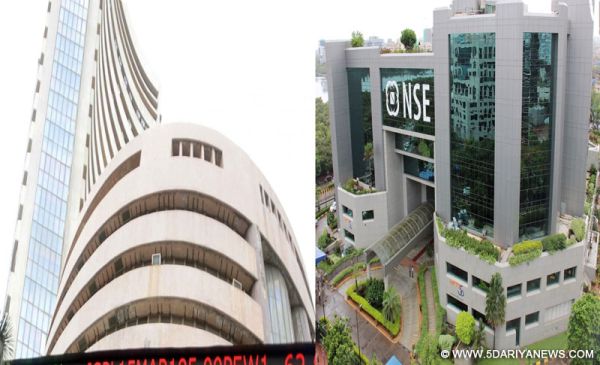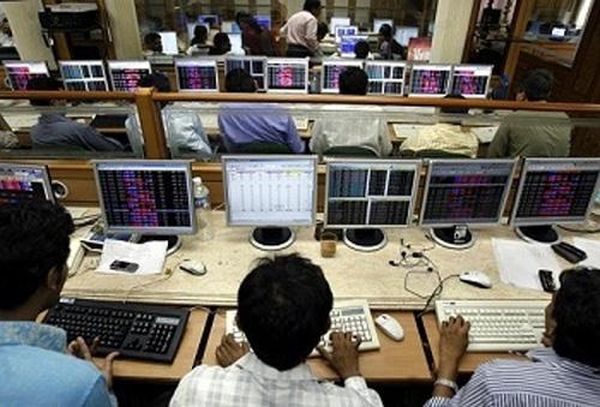
by admin | May 25, 2021 | Banking, Economy, Markets, News
 Mumbai : Breaking a three-day gaining streak, key Indian equity indices closed on a lower note on Wednesday as investors booked profits ahead of the release of important macro-data as well as quarterly earnings results of corporates, according to market observers.
Mumbai : Breaking a three-day gaining streak, key Indian equity indices closed on a lower note on Wednesday as investors booked profits ahead of the release of important macro-data as well as quarterly earnings results of corporates, according to market observers.
Besides, heavy selling pressure in metal, banking and automobile stocks, along with outflow of foreign funds, kept investors’ sentiments subdued.
The wider Nifty50 of the National Stock Exchange (NSE) once again slipped below the psychologically important 10,000-mark — which was reclaimed on Tuesday — to close lower by 32.15 points, or 0.32 per cent, at 9,984.80 points.
The 30-scrip Sensitive Index (Sensex) of the BSE, which opened higher at 31,975.59 points, closed at 31,833.99 points — down 90.42 points, or 0.28 per cent, from its previous close.
The BSE market breadth was bearish — 1,840 declines and 918 advances.
“Nifty showed a bout of volatility in today’s session and closed the day lower by 32 points. Nifty showing sharp intra-day weakness from the highs today is opening up the possibility for more weakness for the coming sessions,” Deepak Jasani, Head – Retail Research, HDFC Securities, told IANS.
“Sectorally, except IT and energy, all the sectors of broader market have closed in the negative. Major Asian markets have ended on mixed trend, while European indices like FTSE 100 and CAC 40 traded lower and DAX traded higher.”
In terms of the broader markets, the S&P BSE mid-cap index fell by 0.82 per cent, while the small-cap index closed lower by 1.08 per cent.
Vinod Nair, Head of Research, Geojit Financial Services, said: “The market failed to hold the opening positive momentum as profit booking emerged towards close due to cautiousness on tomorrow’s (Thursday) CPI (Consumer Price Index) and IIP (Index of Industrial Production) data.”
“Additionally, earnings season will kick-start tomorrow with the result of IT heavyweights and market will take direction from the expectation and the actual numbers,” said Nair.
IT major Tata Consultancy Services (TCS) is expected to be the first blue-chip company to come out with its second quarter (Q2) results on October 12.
“September quarter earnings season is expected to be subdued due to the impact of the Goods and Services Tax (GST). Market heavyweights TCS and Reliance Industries are slated to post results later this week,” said Dhruv Desai, Director and Chief Operating Officer of Tradebulls.
On the currency front, the rupee strengthened by 13-14 paise to close at 65.14-15 against the US dollar from its previous close at 65.28.
In terms of investments, provisional data with the exchanges showed that foreign institutional investors (FIIs) sold scrips worth Rs 107.95 crore while domestic institutional investors (DIIs) purchased stocks worth Rs 233.80 crore.
Sector-wise, the S&P BSE banking index declined by 264.31 points, followed by metal index by 202.63 points and automobile index by 158.88 points.
On the other hand, the S&P BSE oil and gas index rose by 170.86 points, telecom index by 38.33 points and Teck index by 37.36 points.
Major Sensex gainers on Wednesday were: Bharti Airtel, up 5.04 per cent at Rs 403.40; TCS, up 1.66 per cent at Rs 2,500.50; Wipro, up 1.43 per cent at Rs 290.65; Mahindra and Mahindra, up 1.30 per cent at Rs 1,319.70; and Hindustan Unilever, up 0.32 per cent at Rs 1,212.
Major Sensex losers were: Tata Motors, down 2.02 per cent at Rs 415.25; State Bank of India, down 1.97 per cent at Rs 251.60; Dr. Reddy’s Lab, down 1.47 per cent at Rs 2,374.90; Lupin, down 1.42 per cent at Rs 1,045.50; and Tata Steel, down 1.40 per cent at Rs 681.
—IANS

by admin | May 25, 2021 | Business, Investing, Muslim World
 Amman : President of Jordan Businessmen Association (JBA) Hamdi Tabbaa said that establishing a Joint Jordanian-Belgian Business Council in the near future will open new horizons for economic cooperation between the two countries.
Amman : President of Jordan Businessmen Association (JBA) Hamdi Tabbaa said that establishing a Joint Jordanian-Belgian Business Council in the near future will open new horizons for economic cooperation between the two countries.
In a meeting that took place on Tuesday with Belgium Ambassador to Jordan Hendrik van de Velde, Tabaa highlighted investment projects and advantages in the Kingdom, calling at the same time for benefiting from Belgian expertise, especially in the medical and energy fields.
For his part, Ambassador Van de Velde commended Jordan’s role in the Middle East, especially with regard to Syrian and Iraqi reconstruction projects and Jordanian companies’ ability to benefit from those projects, Petra reported.
He called for taking advantages of the Simplified Rules of Origin Agreement and promoting trade and economic relations between the two countries.
A Belgian food industries exhibition will be held soon in Jordan, the ambassador announced.
It is noteworthy that the trade exchange between Jordan and Belgium amounted to $128 million in 2016, $4 million of which were Jordanian exports from the sectors of clothing, fertilizers, and metals.
—SM/IINA

by admin | May 25, 2021 | Employment, Opinions
 By Amit Kapoor,
By Amit Kapoor,
Since the latest growth numbers have come in showing a consistent deceleration in Indias real gross domestic product (GDP) over six consecutive quarters, a cacophony of concerned voices have been heard. The din of criticism both from within and outside the government has grown so loud that Prime Minister Narendra Modi himself has had to intervene in order to defend his economic record. This warrants the question whether the situation is as grave as it is being made out to be. The simple answer is that, in some respects, there is not much that is out of the ordinary about the economic scenario, while in others the trends are cause for concern.
First and foremost are the growth figures. It is not rare for GDP growth to fall for such a long period. In fact, as recently as 2011-12, the GDP had decelerated for exactly six quarters between Q1 of 2011 and Q2 of 2012. By the end of that phase, the growth rate had fallen to a lowly 4.1 per cent. However, in the very next quarter it had bounced back to 6.1 per cent. This is not to make a simplistic argument for complacency, but to point out that growth in developing countries tends to be highly volatile and the Indian economy has shown strong resilience to such downturns. Therefore, a sense of panic is unwarranted and premature.
The second general concern with the economy is slightly more problematic. However, as we will show, it, too, is not out of the ordinary. The level of investment in the economy has become a major cause for concern. As we have pointed out in this column earlier, the level of private and household investment has hit rock bottom and only public investment has been pushing the economy forward. However, World Bank data shows that India’s gross fixed capital formation (GFCF), the leading indicator for investment, has been consistently falling over the last decade. In 2007, India’s GFCF had reached an all-time high of 36 per cent of GDP, close to China’s 39 per cent. Since then, India’s GFCF has fallen to 27 per cent while it has risen to 43 per cent for China. This points to the fact that investment sentiment never recovered in India after the 2008 crisis.
Again, a long-term negative trend is no reason for complacency. According to the RBI’s Annual Report, the non-food credit take-off across the country has been at its lowest in almost 25 years. Low credit take-off indicates that industrialists are unsure of future prospects and have postponed investments owing to weak demand. The twin balance sheet problem that is the leading cause behind the muted investment sentiment needs to be urgently resolved. Fortunately, the government has been proactive on this front and is taken some positive steps to resolve bad debts of big accounts.
Apart from the fact that growth and investment have historically shown poor trends and that we are not in a unique situation, the fundamentals of the economy are significantly stronger than usual. The government has done a good job of sticking to its fiscal deficit targets while the RBI has done the same with inflation. Moreover, the country’s foreign exchange reserves have crossed $400 billion — huge by any standard. To put things in perspective, these reserves equalled 78 percent of India’s total external debt (both short and long term) at the end of March. It may be debatable whether the country needs such a huge trove of reserves, but they are considerable enough to ensure short-run and medium-term stability of the economy.
The most concerning factor of the economy, which also has had a similar long-term history, is unemployment. Lack of jobs is an aspect of the Indian economy that simply can no longer be ignored. Since India missed its own industrial boom and directly ended up becoming a service-led economy, jobless growth has been a problem for long. This is because services are not as labour-intensive as manufacturing. However, the situation has worsened more recently. Between March 2014 and 2016 India experienced an absolute decline in employment, probably for the first time since independence, as pointed out by the Economic and Political Weekly. A fall in the absolute number of jobs for a developing country like India, where 10 million people are expected to join the workforce annually, is disastrous, to put it mildly.
All in all, the falling growth rate will reverse its trend soon as history proves. This will happen over the next few quarters as the after-effects of the twin shocks of demonetisation and GST subside. Investment will hopefully see a revival once the banks find their balance sheets improving. But the problem of job growth will pose the real challenge to the Modi government.
The recent frenzy around the deceleration of GDP growth does not do justice to this structural problem with the economy. Growth rates are understandably volatile and the fall in this period has been accentuated by demonetisation and the implementation of GST. The economy is resilient enough to extricate itself out of these shocks and, in fact, the latter will only be beneficial in the long run. The real problem lies with job creation and it was not a problem created yesterday. The problem of jobs is deep-rooted within the economy and will require equally deep-rooted reforms. The specifics of those reforms are a discussion for another day — but we need to begin by shifting our focus to the appropriate concerns.
(Amit Kapoor is chair, Institute for Competitiveness, India. The views expressed are personal. He can be contacted at amit.kapoor@competitiveness.in and tweets @kautiliya. Chirag Yadav, researcher, Institute for Competitiveness, India has contributed to the article.)
—IANS

by admin | May 25, 2021 | Employment, Muslim World, Overseas

Minister of Tourism, Air Transport, Crafts and Social Economy, Mohammed.
Rabat : With a turnover of MAD 115 billion in 2016, tourism contributed 7 percent of the national GDP and helped create nearly 2.5 million direct and indirect jobs in Morocco, said Minister of Tourism, Air Transport, Crafts and Social Economy Mohammed Sajid.
Speaking in the governing council on Thursday in Rabat, Sajid noted that the sector recorded MAD 64.2 million in foreign exchange earnings, with the number of tourists increasing from 9.3 million to 10.3 million between 2010 and 2016.
The minister also noted that the occupancy rate of hotels has scarcely exceeded 40 percent, which is one of the major challenges facing the sector.
Sajid also stressed the importance of tourism as a horizontal sector requiring the convergence of public policies and the involvement of all sectors to make it a priority, Morocco World News reported.
He recalled the profound changes that are taking place in the sector through technological and numerical developments, as well as geostrategic and political changes in the surrounding region.
In addition, he highlighted the role of tourism in economic development, as the second largest contributor to national GDP. For 2017, Ouarzazate recorded the best national performance for overnights, with a 41 percent increase in the number of tourists compared with the same period in 2016, according to the provincial tourism office.
The month of July saw major growth, with a 77 percent increase in arrivals and a 75 percent overnight stays compared to 2016.
The total number of tourists who visited the region rose from 109,474 for the first seven months of 2016 to 154,677 for the same period of 2017, up by 41 percent.
—SM/IINA

by admin | May 25, 2021 | Economy, Markets, News
 By Rohit Vaid,
By Rohit Vaid,
Mumbai : The upcoming quarterly results season, along with key macro-economic data points, are expected to determine the trajectory of equity indices next week.
Market observers opined that global cues, combined with the direction of foreign funds, will also impact investors’ risk-taking appetite.
“Markets would look to the upcoming earnings season, though the expectations remain muted on weaker growth on the back of GST implementation. The divergence of weak Indian macros and buoyant global growth, combined with higher Indian market valuations, will keep the positive momentum in Indian markets capped,” Zyfin Advisors’ Chief Executive Devendra Nevgi told IANS.
“Fiscal overruns and inflation stickiness and the lack of other adequate levers to pump growth will result in markets relying on domestic liquidity for help,” Nevgi added.
IT major Tata Consultancy Services (TCS) is expected to be the first blue chip to come out with its second quarter (Q2) results on October 12.
“Domestic market is concerned with the lack of earnings growth — led by GST disruption and reduction in liquidity by global central banks… However, in the near term, Q2 earnings will be the key factor which will determine the direction of the market,” elaborated Vinod Nair, Head of Research at Geojit Financial Services.
Apart from the Q2 results, investors will also look out for the upcoming macro-economic data points such as the IIP (Index of Industrial Production) figures.
The Central Statistics Office (CSO) is slated to release the macro-economic data points of IIP and CPI (Consumer Price Index) on October 12, Thursday.
Besides the macro-economic data points, rupee’s movement against the US dollar and an outflow of foreign funds could make investors nervous.
The Indian rupee weakened by nine paise on last Friday to close at 65.38 to a US dollar from its previous week’s close at 65.29.
In addition to Indian currency, provisional figures from the stock exchanges showed that foreign institutional investors (FIIs) off-loaded stocks worth Rs 3,022.07 crore.
Figures from the National Securities Depository (NSDL) revealed that foreign portfolio investors (FPIs) divested equities worth Rs 550.75 crore during October 3-6.
“FPIs have sold over $2 billion in Indian equities over the past couple of months as they grow cautious due to economic growth slowing down and expensive stock prices. A constant outflow of foreign investment from domestic equity markets have weighed on rupee,” Anindya Banerjee, Deputy Vice President for Currency and Interest Rates with Kotak Securities, told IANS.
“As a result, we can see USD-INR rise towards 66/66.20 levels in the coming days from 65.35 now. However, we do not expect USD-INR to sustain above 66.20 levels for long, as RBI is expected to remain a seller at higher levels to contain volatility.”
On technical charts, Nifty can move towards record highs after crossing the 9,980-10,000 points hurdle.
“Nifty’s sharp bounce back on Friday has opened up possibility of a further up-move in the early part of next week,” said Deepak Jasani, Head of Retail Research for HDFC Securities.
“A decisive move above the hurdle of 9,980-10,000 points level could lead Nifty to move towards the recent all-time high of around 10,178 points level in the next 1-2 weeks. On down moves, it could take support at 9,830 points.”
Last week, the key Indian equity indices — the BSE Sensex and the NSE Nifty — rose on the back of global cues, along with healthy macro and auto sales data.
Consequently, the 30-scrip Sensitive Index (Sensex) of the BSE surged by 530.5 points, or 1.7 per cent to 31,814.22 points.
Similarly, the Nifty50 of the National Stock Exchange (NSE) edged higher by 191.1 points, or 1.95 per cent to close the week’s trade at 9,979.70 points.
(Rohit Vaid can be contacted at rohit.v@ians.in)
—IANS

 Mumbai : Breaking a three-day gaining streak, key Indian equity indices closed on a lower note on Wednesday as investors booked profits ahead of the release of important macro-data as well as quarterly earnings results of corporates, according to market observers.
Mumbai : Breaking a three-day gaining streak, key Indian equity indices closed on a lower note on Wednesday as investors booked profits ahead of the release of important macro-data as well as quarterly earnings results of corporates, according to market observers.



